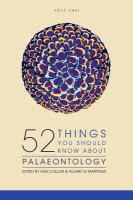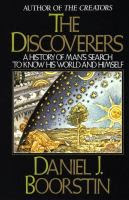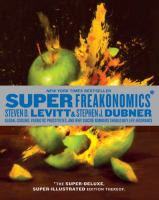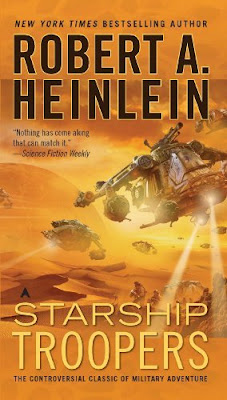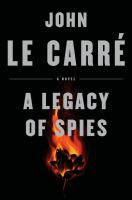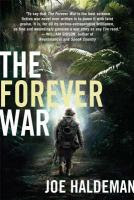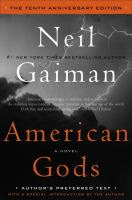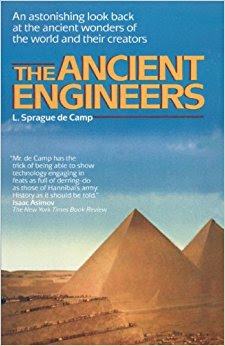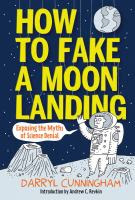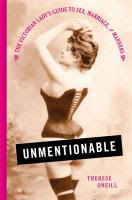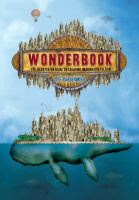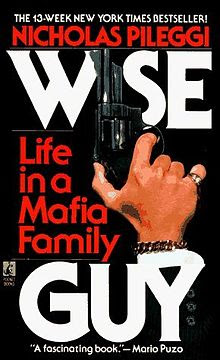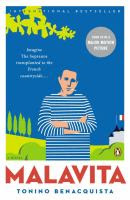A book review site. Enjoy! Comments are welcome (but they are moderated).
If there is a book you'd like to suggest I read please let me know by checking out my reading criteria via the button below.
2017-12-25
"52 Things You Should Know About Palaeontology" edited by Alex Callum & Allard W. Martinius
Publisher:[Mahone Bay] Nova Scotia : Agile Libre, 2015.
ISBN: 9780987959447
Characteristics: 137 pages :,illustrations, map ;,23 cm.
Additional Contributors:Martinius, Allard W. 1963-
Cullum, Alex 1969-
When I first came across this title*, I was doing some research for a book on palaeontology, it's historical roots and interaction with anthropology. It looked interesting, and based solely on the title I assumed it was a book directed towards young people (which my research was sorely lacking at the time). When I finally got my hands on a copy I was both a little sad that this wasn't what it was about, but also very much happier when I read the table of contents and found out that this was a compilation of 52 short papers by leading palaeontologists and others in the field from around the world describing their work.
This book gives the reader a basic introduction to the basic science of palaeontology, it's history, and many other related topics. Each of the papers is two pages long, and should whet your appetite to look into the subject areas in more detail.
The various papers in this book touch on the fundamentals of palaeontology, its biology, applying what is learned, teaching the science, stratigraphy, methodology, fossils, and culture with a given paper typically talking about more than one of these subject areas and showing how they all interrelate.
As someone who works in the field and gives tours to school groups and other visitors to our lab (University of Alberta) I believe this book would be quite a valuable resource to any high school library, public library, college or university as it is very complete.
The authors have also published a follow-up to this book entitled "52 More things You Should Know About Palaeontology" which I have yet to read, but will be doing so shortly.
* Kudos to the editors by the way for spelling palaeontology correctly - this is one of my nit-picky complaints as the people who work with me can attest to.
2017-12-18
"Artemis" by Andy Weir
Publisher:New York : Crown, [2017]
Edition:First edition.
Copyright Date:©2017
ISBN: 9780553448122
Characteristics: 305 pages :,illustrations ;,25 cm
Artemis is Mr. Weir's second novel, and he has followed up "The Martian" with another great story. I believe this one would also make a great movie in the event someone from Hollywood happens to be reading this blog (yeah, right!). As it has the elements of a great adventure story, with political intrigue, a strong protagonist, and much more.
The story revolves around a lunar resident by the name of Jazmine Bashara who seeks out a living (not always legally) in the only inhabited city on the moon. Her life suddenly gets very interesting however, when she is offered an opportunity she can't really refuse. But which turns out to be a little more complicated than she planned on.
Mr. Weir is one of few authors today who writes in first person, and this gives the story a very immediate feel that many novels now-a-days never get close to. Many writers seem to shy away from first person, and more writing teachers, and resource material seems to advise against using it. Now while this may be good advice for an absolute beginning writer, it is quite refreshing (in my opinion at least) to read stories told this way.
In addition, Mr. Weir definitely did a fair bit of research when planning the city of Artemis and this has really paid off, as the technology behind the story is very consistently designed, and believable.
I eagerly await his next book, as I'm sure after two hits he'll be able to keep going.
2017-12-11
"Astrophysics for People in a Hurry" by Neil de Grasse Tyson
Publisher:New York : W.W. Norton & Company, [2017]
Edition:First edition.
Copyright Date:©2017
ISBN: 9780393609394
Characteristics: 222 pages
I really enjoyed this book and think that Dr. Tyson's explanations of astrophysics are very complete and extremely easy to understand with little math required. I'm not sure when I first became aware of Dr. Tyson's work, but I believe it was possibly during the controversy that erupted following the demotion of Pluto from a planet to a dwarf planet in 2006. I grew up in a time when we all thought that the solar system had nine planets, and now we have eight, so what? It was either that or when I saw the updated series Cosmos: A Spacetime Odyssey, which I feel is a great complement to the original series by the late Dr. Carl Sagan. If you haven't seen this series, I would definitely encourage you to do so, but would recommend that you watch the original first.
In any case, "Astrophysics for People in a Hurry" is a great book, and well worth the read. I've been a fan of space for many decades, but still learned a fair bit from this book which examines topics such as the Big Bang, Dark Matter, Dark Energy, and much more.
Dr. Tyson's sense of humour is quite unique, and adds to the fun of what some might think of as a rather unwieldily topic for a book that is marketed to the general public. His views on the viability of levitation are very interesting, and I would be very interested in seeing his equations on how this could be accomplished, and even more so in see an actual demonstration (but preferably not inside a closed room).
2017-12-04
"The Discoverers" by Daniel J. Boorstin
Daniel J. Boorstin (1914-2004)
Publisher:New York : Random House, [1983]
Copyright Date:©1983
ISBN: 9780394726250
Characteristics: xvi, 745 pages ;,24 cm
The overview of this book says that it is "An original history of man's greatest adventure: his search to discover the world around him. In the compendious history, Boorstin not only traces man's insatiable need to know, but also the obstacles to discovery and the illusion that knowledge can also put in our way. Covering time, the earth and the seas, nature and society, he gathers and analyzes stories of the man's profound quest to understand his world and the cosmos."
This book is one of three Mr. Boorstin wrote in this same vein, the others being "The Creators" and "The Seekers".I haven't read either of these yet, but they are on my list, and will be reviewed in time.
The Discoverers was a fascinating book, and even thought it took me a long time to read it (684 pages of text) it was well worth the time. I believe this book (and possibly the other two mentioned above as well) would make fantastic texts for a history or anthropology class at the University level. Granted that the majority of students might not read them, but those that did would benefit immensely from the information to be gained.
The book is separated into four major divisions Time, The Earth and the Seas, Nature, and finally Society. Within each of these are sub sections that breakdown the divisions into more manageable works. These are sub sequentially separated into chapters dealing with a specific idea.
The detail with which Mr. Boorstin was able to present this information is wonderful. An example of this from the section of Time is: "Part I: The Heavenly Empire" which deals with rudimentary astronomy and it relation to astrology and how it was connected with religion and how they all influenced various historical events.
"Part II: From Sun Time to Clock Time" traces the development of time keeping through its many phases. Including Calendars, Sun Dials, Clocks, Time Keeping at Sea which allowed for the determination of longitude, etc.
I could go on and give an overview of the entire book, but then you wouldn't have to read it, which is something you should definitely do! All in all this was a great book, and I'm looking forward to reading the next ones in the series, however I won't be reading them right away as it will take me a while to digest all the information presented in this volume.
2017-11-27
"Superfreakonomics" by Steven Levitt & Stephen J. Dubner
Publisher:New York : William Morrow, [2010]
Edition:First edition, illustrated edition.
Copyright Date:©2010
ISBN:9780061941221
Characteristics:xxi, 281 pages :,color illustrations ;,27 cm
Superfreakonomics was a delight to read, as well as being very informative. I had read Freakonomics a few years ago and found that it too was well researched and well presented (however this was before I started writing reviews on this blog). I never took any microeconomics courses while I was in university but a book like this makes me wish I had done so.
The in depth examination of the Kitty Genovese murder was very interesting to read. My first exposure to this tale was during one of my psychology course at University, and like is mentioned in Superfreakonomics it was the standard telling (accounts from the regular news media), and that was many years after the fact as I was very young when it happened. The information provided in this book however sheds new light on the subject and makes you pause and think, rather than just be abhorred by the the bystanders did (or in this case didn't do).
Two other chapters that were very thought provoking was the one on global warming and the final one about monkeys. I would definitely like to hear more about the monkeys!
One criticism I have though is that when you consider that Canada is the Northern neighbour of the United States, and that we share the longest undefended border in the world. It seems odd to not see any mention of our existence in the book, mind you this is rather typical to a certain point in pretty much all books published in America so I guess I can't fault them on that (well, not too much at least).
All-in-all a very good book worth taking a good look at, you do tend however to want to read a whole chapter at once (and they're fairly long) so brew a big pot of tea and go to it. For sake of clarity I would recommend that you only read one chapter per day (or however long it takes, as there is a lot of information to absorb), and then sit back and reflect on what you have read.
2017-11-20
"Starship Troopers" by Robert A. Heinlein
Publisher:New York : Ace Books, 1987.
Copyright Date:©1959
ISBN:9780441014101
Characteristics:208 pages ;,18 cm
"Starship Troopers" is a book that I first read many decades ago. I loved it then, and I still think it is one of the best Science Fiction based war books around. Having just finished "The Forever War" by Joe Haldeman, I was drawn to read it again, and found the story to be good as ever.
The book was first published in the early 1960s, and while there has been tonnes of controversy surrounding it, it still remains a classic. The controversy primarily surrounds it's political views, which take on Marxism head on, and in my opinion wins. The story itself is set in the far distant future, where the only people with a vote in society (or hold political office, law enforcement positions, etc.) are those who have completed military service. Military service however is not compulsory, and is totally voluntary but if you don't serve you aren't a full citizen. Because of this the world is essentially politically stable, relatively crime free, and quite technologically advanced. Due to the political outlook, however some have labelled this is a fascist state, which I believe is a very simplistic way to look at things.
It is interesting to note that when this book was written (in 1959), Mr. Heinlein accurately predicted the state our society is currently in when he describes such things as street gangs, people being afraid to walk the streets at night, child crime, etc. I'm not sure how he predicted this so accurately, but he did.
The protagonist is Juan Rico (Johnny) who enlists shorty after his 18th birthday when he finds out his two best friends are planning on doing the same. The reader is then taken through Johnny's time in Basic Training, which some have said is overly harsh, but in actually is very realistic (been there, done that).
As many people know Paul Verhoeven adapted this book for a movie back in 1997. I've seen the movie, and the first thing that came to my mind when I left the theatre was: did Mr. Verhoeven do anything other than read the blurb on the back cover? It's true he got Johnny's name close to correct (but not as Juan), but the rest of the story is so totally different that he could have saved himself a lot of money purchasing the rights.
Highly recommended as a great story for all to read.
"Starship Troopers" is a book that I first read many decades ago. I loved it then, and I still think it is one of the best Science Fiction based war books around. Having just finished "The Forever War" by Joe Haldeman, I was drawn to read it again, and found the story to be good as ever.
The book was first published in the early 1960s, and while there has been tonnes of controversy surrounding it, it still remains a classic. The controversy primarily surrounds it's political views, which take on Marxism head on, and in my opinion wins. The story itself is set in the far distant future, where the only people with a vote in society (or hold political office, law enforcement positions, etc.) are those who have completed military service. Military service however is not compulsory, and is totally voluntary but if you don't serve you aren't a full citizen. Because of this the world is essentially politically stable, relatively crime free, and quite technologically advanced. Due to the political outlook, however some have labelled this is a fascist state, which I believe is a very simplistic way to look at things.
It is interesting to note that when this book was written (in 1959), Mr. Heinlein accurately predicted the state our society is currently in when he describes such things as street gangs, people being afraid to walk the streets at night, child crime, etc. I'm not sure how he predicted this so accurately, but he did.
The protagonist is Juan Rico (Johnny) who enlists shorty after his 18th birthday when he finds out his two best friends are planning on doing the same. The reader is then taken through Johnny's time in Basic Training, which some have said is overly harsh, but in actually is very realistic (been there, done that).
As many people know Paul Verhoeven adapted this book for a movie back in 1997. I've seen the movie, and the first thing that came to my mind when I left the theatre was: did Mr. Verhoeven do anything other than read the blurb on the back cover? It's true he got Johnny's name close to correct (but not as Juan), but the rest of the story is so totally different that he could have saved himself a lot of money purchasing the rights.
Highly recommended as a great story for all to read.
2017-11-15
"A Legacy of Spies" by John Le Carré
Publisher: [Toronto] Viking, 2017
ISBN: 9780735234529
Characteristics: 264 pages
Once again Mr. Le Carré has written a superb novel. This story once again revolves around the the actions of the Circus and George Smiley, and fills in a portion of the back story that fans have likely been curious about for many years. While Mr. Le Carré hasn't written a Smiley novel in 25 years, the same panache and expert storytelling hasn't gone away in this page turner.
If you have never read any of the George Smiley novels - "Call for the Dead" (1961); "A Murder of Quality" (1962); "The Spy Who Came in from the Cold" (1963); "The Looking Glass War" (1965); "Tinker, Tailor, Soldier, Spy" (1974); "The Honourable Schoolboy" (1977); "Smiley's People" (1979); and "The Secret Pilgrim" (1990) - then you might want to tackle them first however this means you'll have to put off reading "A Legacy of Spies" until much later, which would be a shame. If however you want to read "A Legacy" right away then read "Tinker, Tailor Soldier, Spy" and you'll be in the groove.
While the Cold War subject matter is based of factual events and the world of George Smiley and his fellow clandestine operatives is fictional, I am in awe at the amount of research that Mr. Le Carré had to have done to make these novels seem so realistic is astounding. If on the other hand he did minimal research then it is even more amazing as this and the other novels in the series are so well crafted that they are very difficult to put down even for short breaks.
After reading this novel, I plan to go back and reread all the other George Smiley novels to refresh my memory of all the details. This will however take some considerable time. However seeing as there are likely numerous reviews of these great stories already it is unlikely that I'll review them on this blog.
I hope you enjoy this novel as much as I did!
Publisher: [Toronto] Viking, 2017
ISBN: 9780735234529
Characteristics: 264 pages
2017-11-06
"From Here to Eternity" by Caitlin Doughty
Publisher:New York : W.W. Norton & Company, [2017]
Edition:First edition.
Copyright Date:©2017
ISBN:9780393249897
I had eagerly been awaiting the release of this book since I first heard about it on the YouTube channel Ask a Mortician which is run by Ms. Doughty as is the website The Order of the Good Death. It definitely lived up to all my expectations as it was a fantastic read and definitely gave me insight into other cultures and practises of how they treat their deceased.
Ms. Doughty wrote about eight different funerary practises in six different places, three of these were in the United States, but they were different enough from each other to make them worth including. The ones outside the United States were South Sulawesi, Indonesia; Michoacán, Mexico; Barcelona, Spain; Tokyo, Japan and La Paz, Bolivia. The three United States visits were in Crestone, Colorado; Cullowhee, North Carolina; and Joshua Tree, California. In the epilogue Ms. Doughty also treats us to a view of some of the practises in Vienna, Austria.
Despite what some may expect or want this book is not a simple travelogue designed to shock the reader into what people do with bodies in other cultures. Instead it is an insightful look into different cultural practises surrounding death, in cultures that treat death not as something to be afraid of (as it is typically in the Western World), but as something to celebrate both the life of the individual as well as the ongoing lives of the rest of the deceased's family.
It is my sincere belief that everyone should have this book (and her first as well "Smoke Gets in Your Eyes - Lessons from the Crematory) on their to-be-read list, and if it's already there move it further up on the list so you can get to it sooner rather than later. Westerners for the most part are scared of death and all it's ramifications, due primarily to in my opinion the hold organized religion has on our culture. It's about time that we started to think otherwise, as whether you like it or not you will die.
Having been trained as an anthropologist, I can see the value of this book a either one of the texts in an introductory anthropology course, or as the main one in a senior course on death acceptance and practises. As I also hold a degree in Education, I would like to see this subject taught in schools as well, however I realize this will likely never happen, after all we still have many who oppose the teaching of sex education in schools.
I do hope that Ms. Doughty will consider writing a sequel to this book, and explore even more cultures and their death practises.
2017-10-30
"The Forever War" by Joe Haldeman
Publisher:New York : St. Martin's Griffin, [2009]
Copyright Date:©1997
ISBN:9780312536633
Characteristics:xviii, 264 pages ;,21 cm
The Forever War was a very well written book based on the authors experiences in Vietnam. It was written in 1974, and as the author explains in his introduction as long as you can get past the part where the beginning of the novel is set in the late 1990s then you're good to go.
The premise of the book is that a new recruit William Mandella is one of the first troopers to be dispatched to fight what turn out to be a clone warrior species named the Taurans. What I found to be one of more interesting aspects of this story is the fact that Mr. Haldeman actually did research on relativity and took this into account. The vast majority of Science Fiction stories don't do this and assume Einstein's theory is somehow gotten around. Not so in "The Forever War" as while Mandella's first deployment takes 2 years his time, 10 years have passed on Earth.
Other things on good ol' Earth are different as well, the population is growing at an alarming rate, and this has led many people to develop same-sex relationships in an attempt curb the population. Later on we find that this is encouraged by Earth's authorities, but that nobody bothered to tell the troopers who are still heterosexual. Needless to say this causes a number of problems for Mandella, and he therefore re-enlists spending more years in the service, in ever longer voyages which results in even more time dilation.
In many instances there isa great deal of humour in the story, though possibly not intentionally as at one point Mandella comes back to Earth to find that virtually the entire population in homosexual, and in a total reverse heterosexuality is now considered to be aberrant behaviour and he's labelled the "old queer".
A very good read - not sure why it took me so long to read it!
The Forever War was a very well written book based on the authors experiences in Vietnam. It was written in 1974, and as the author explains in his introduction as long as you can get past the part where the beginning of the novel is set in the late 1990s then you're good to go.
The premise of the book is that a new recruit William Mandella is one of the first troopers to be dispatched to fight what turn out to be a clone warrior species named the Taurans. What I found to be one of more interesting aspects of this story is the fact that Mr. Haldeman actually did research on relativity and took this into account. The vast majority of Science Fiction stories don't do this and assume Einstein's theory is somehow gotten around. Not so in "The Forever War" as while Mandella's first deployment takes 2 years his time, 10 years have passed on Earth.
Other things on good ol' Earth are different as well, the population is growing at an alarming rate, and this has led many people to develop same-sex relationships in an attempt curb the population. Later on we find that this is encouraged by Earth's authorities, but that nobody bothered to tell the troopers who are still heterosexual. Needless to say this causes a number of problems for Mandella, and he therefore re-enlists spending more years in the service, in ever longer voyages which results in even more time dilation.
In many instances there isa great deal of humour in the story, though possibly not intentionally as at one point Mandella comes back to Earth to find that virtually the entire population in homosexual, and in a total reverse heterosexuality is now considered to be aberrant behaviour and he's labelled the "old queer".
A very good read - not sure why it took me so long to read it!
2017-10-23
"American Gods" by Neil Gaiman
Publisher:New York : William Morrow an imprint of HarperCollins Publishers, [2011]
Edition:Tenth anniversary edition.
Copyright Date:©2011
ISBN:9780062059888
Characteristics:xiv, 541 pages ;,24 cm
American Gods was a very interesting story, that was well crafted, a very good read and kept you turning the pages. This is only the second of Neil Gaiman's books that I've read (the first being "Norse Mythology" which was reviewed back on July 17, 2017.
There were a couple of times in this story where I was a little confused as Mr. Gaiman does bring in a lot of his back story from Norse and other mythologies, but this lack of understanding was totally my fault as I simply had never heard of some of the other deities that were introduced.
Mr. Wednesday (who I knew to be Odin) from the very first time he was mentioned was a good character to have the story revolving around (yes, I did listen in my Norse Mythology class at University), even though he isn't the main character (that's Shadow). With the antagonists being more modern gods (credit cards, television, etc.), you get an automatic conflict that produces some interesting twists.
Throughout the book Shadow (who is now Wednesday's bodyguard, is introduced to a number of Wednesday's friends (and a few enemies) who turn out to be other gods that have been brought to North America in the minds of immigrants. There are some strictly American gods as well such as Johnny Appleseed, too that he encounters. The antagonists as mentioned above are the newest gods on the scene, and are what people worship today the internet, television, unending credit, etc. - don't believe me just look around you everybody has got their nose pointed at a little screen.
All in all this is a very good read. I recently noticed that there was a television series made of it, but whether I get around to watching is will be another story entirely as one thing I don't do is worship the idiot box.
American Gods was a very interesting story, that was well crafted, a very good read and kept you turning the pages. This is only the second of Neil Gaiman's books that I've read (the first being "Norse Mythology" which was reviewed back on July 17, 2017.
There were a couple of times in this story where I was a little confused as Mr. Gaiman does bring in a lot of his back story from Norse and other mythologies, but this lack of understanding was totally my fault as I simply had never heard of some of the other deities that were introduced.
Mr. Wednesday (who I knew to be Odin) from the very first time he was mentioned was a good character to have the story revolving around (yes, I did listen in my Norse Mythology class at University), even though he isn't the main character (that's Shadow). With the antagonists being more modern gods (credit cards, television, etc.), you get an automatic conflict that produces some interesting twists.
Throughout the book Shadow (who is now Wednesday's bodyguard, is introduced to a number of Wednesday's friends (and a few enemies) who turn out to be other gods that have been brought to North America in the minds of immigrants. There are some strictly American gods as well such as Johnny Appleseed, too that he encounters. The antagonists as mentioned above are the newest gods on the scene, and are what people worship today the internet, television, unending credit, etc. - don't believe me just look around you everybody has got their nose pointed at a little screen.
All in all this is a very good read. I recently noticed that there was a television series made of it, but whether I get around to watching is will be another story entirely as one thing I don't do is worship the idiot box.
2017-10-16
"The Ancient Engineers" by L. Sprague de Camp
Back when I first read this book (or at least portions of it), I was an undergrad student at the University of Alberta. The class I was assigned this in was a overview of classical technology. I don't remember the actual course designation anything but it was a very good course and I thoroughly enjoyed it.
At the time I did not know L. Sprague de Camp as anything other than a science-fiction writer. I was soon to find out that he worked alongside other great authors such as Robert A. Heinlein and Isaac Asimov and numerous others who also became famous science-fiction authors.
This book is an overview of the history of engineering from pretty much the very beginning until approximately the 1960s. It was written in 1960 and this therefore limited the author in what he could talk about. In some places I felt Mr. de Camp tended to skip over or at least gloss over some of the pertinent details that led to the invention being discussed but for the most part he gives a very good review of how engineering developed, the people in involved and the historical events that were occurring at that time.
The only major criticism I have of this book (which quite likely may be a minor one for many readers) is that they were nowhere near enough illustrations and other graphical forms of information to allow the reader to understand what is being explained. However, if these were included the book would need to be expanded to multiple volumes.
The book itself is organized by time period, and this does cause some confusion when speaking about certain types of inventions, as there is significant overlap in most of these sciences. I believe it might've been easier to read if the book was to be organized based on the given type of invention and proceeded from the very beginning street to the modern times.
It would be great to see a new edition of this book be published that takes up where Mr. de Camp left off, unfortunately he died in 2000 so it will have to be by someone else.
2017-10-09
"Rendezvous With Rama" by Arthur C. Clarke
Publisher:New York : Bantam Books, 1990.
Edition:Bantam edition.
Copyright Date:©1973
ISBN:9780553287899
Characteristics:243 pages
Rendezvous with Rama, is one of the classics of science fiction. For those who have not read the book it describes a first contact situation in the year 2130 when a new celestial object is discovered in the solar system heading towards the sun. It is named Rama after the Hindu god, who is the seventh avatar of Vishnu.
This object turns out to be a gigantic spaceship some 50 kilometres long and 20 kilometres in diameter. The story revolves around a brief three week investigation by "The Endeavour" commanded by William Norton which is the only ship able to reach Rama while is approaching perihelion with the sun.
The book itself is extremely well written as are virtually all of Arthur C. Clarke's works.
I first read this book many years ago, back when I believe I was in either high school or possibly even junior high. When I first read this book I enjoyed it quite a bit but don't know if I really grasped all the nuances of the story itself.
On my second reading (yes, it took me a while to get around to reading it again) I found that it is well-crafted and quite suspenseful, even though the characters themselves are a bit two-dimensional (at least in my opinion).
In today's style of writing it probably would not be considered suspenseful or adventurous as authors now-a-days tend to lean more towards battle sequences and the like whereas this story is essentially more of a traditional mystery. I'm not sure why author's today seem to intentionally neglect more thoughtful stories, but it may have something to do with the way everyone today is wired, and on-line all the time (but who really knows as I didn't take many psychology courses).
Two or three books followed this one a number of years later, and they will be reviewed at a later date, as I've not read any of them so far.
2017-10-02
"How to Fake A Moon Landing: Exposing the Myths of Science Denial" by Darryl Cunningham
Publisher:New York : Abrams ComicArts, 2013.
ISBN:9781419706899
Characteristics:172 pages, 4 unnumbered pages :,color illustrations
Alternative Title:Previously publushed as: Science tales: lies, hoaxes, and scams.
This book explores eight common science denial areas in cartoon format, and does it very well. Mr. Cunningham deals with the topics: The Moon landing hoax, Homeopathy, Chiropractic medicine, Vaccinations, Evolution, Fracking, Climate Change, and General Science Denial as does so in a way that will appeal to people of all ages.
A quote from Michael Specter a staff writer for the New Yorker as well as an author states the overall thesis behind this book on page 2 by saying:
"Everyone is entitled to their own opinion; however, everyone is not entitled to their own facts."
The eight myths contained within this book are all refuted, by reviewing them in a rational, and logical way with simple explanations as to why they are false and providing the scientifically based reasoning behind the evidence.
While I'm sure this book won't convince the die-hard science denial fans, it will hopefully at least start to drive a wedge into their armour and therefore show everyone that their one sided opinions are not sustainable in a rational discussion.
Another quote, this time from the preface:
"... [T]he universe has amazing and strange qualities anyway for those who care to see them. There is no need to believe in fantasy in order to see the extraordinary in the world, when reality offers up so much that is astonishing." (pg. 6)
Pick this book up, and enjoy it.
This book explores eight common science denial areas in cartoon format, and does it very well. Mr. Cunningham deals with the topics: The Moon landing hoax, Homeopathy, Chiropractic medicine, Vaccinations, Evolution, Fracking, Climate Change, and General Science Denial as does so in a way that will appeal to people of all ages.
A quote from Michael Specter a staff writer for the New Yorker as well as an author states the overall thesis behind this book on page 2 by saying:
"Everyone is entitled to their own opinion; however, everyone is not entitled to their own facts."
The eight myths contained within this book are all refuted, by reviewing them in a rational, and logical way with simple explanations as to why they are false and providing the scientifically based reasoning behind the evidence.
While I'm sure this book won't convince the die-hard science denial fans, it will hopefully at least start to drive a wedge into their armour and therefore show everyone that their one sided opinions are not sustainable in a rational discussion.
Another quote, this time from the preface:
"... [T]he universe has amazing and strange qualities anyway for those who care to see them. There is no need to believe in fantasy in order to see the extraordinary in the world, when reality offers up so much that is astonishing." (pg. 6)
Pick this book up, and enjoy it.
2017-09-25
"Unmentionable The Victorian Lady's Guide to Sex, Marriage, and Manners" by Therese Oneill
Publisher:New York : Little, Brown and Company, 2016.
Edition:First edition.
Copyright Date:©2016
ISBN:9780316357913
Characteristics:viii, 307 pages :,illustrations
Unmentionable is a fascinating look at what the Victorian Age. Ms. Oneill gives you the unvarnished truth behind what life back then was really like. The premise behind this book is that a modern woman takes a trip back in time, and lives in the 19th century, with Ms. Oneill as her guide. She does the whole thing with a humorous twist that keeps you reading, long after the light should have been out.
Many people believe they know what the 19th century was like from watching movies, and reading popular novels, and romances. However reality was much different, as the author reveals interesting items such as bathing habits (pretty much none), using arsenic as a facial cleanser, lead based cosmetics made from lead and lard (that isn't a typo), diets, courtship, what a woman should expect on her wedding night, birth control (or lack thereof in most cases), public behaviour, how to be a good wife, etc.
Now as a male, I was not the intended audience for this book, but I still found it absolutely fascinating. It is true my conceptions of the 19th century were totally skewed, but now I have seen the light. While I haven't written any historical fiction set in the the 19th century, I believe I would like to give it a try someday, but the amount of research needed to make it authentic would be mind blowing. Luckily, Ms. Oneill gives a detailed bibliography.
This book would be a fantastic resource for any writer of historical fiction, historical commentary, science-fiction (for those into time travel). In addition to this you can add students of history, anthropology, politics, gender studies, etc.
Unmentionable is a fascinating look at what the Victorian Age. Ms. Oneill gives you the unvarnished truth behind what life back then was really like. The premise behind this book is that a modern woman takes a trip back in time, and lives in the 19th century, with Ms. Oneill as her guide. She does the whole thing with a humorous twist that keeps you reading, long after the light should have been out.
Many people believe they know what the 19th century was like from watching movies, and reading popular novels, and romances. However reality was much different, as the author reveals interesting items such as bathing habits (pretty much none), using arsenic as a facial cleanser, lead based cosmetics made from lead and lard (that isn't a typo), diets, courtship, what a woman should expect on her wedding night, birth control (or lack thereof in most cases), public behaviour, how to be a good wife, etc.
Now as a male, I was not the intended audience for this book, but I still found it absolutely fascinating. It is true my conceptions of the 19th century were totally skewed, but now I have seen the light. While I haven't written any historical fiction set in the the 19th century, I believe I would like to give it a try someday, but the amount of research needed to make it authentic would be mind blowing. Luckily, Ms. Oneill gives a detailed bibliography.
This book would be a fantastic resource for any writer of historical fiction, historical commentary, science-fiction (for those into time travel). In addition to this you can add students of history, anthropology, politics, gender studies, etc.
2017-09-18
"Wonderbook" by Jeff VanderMeer
Publisher:New York : Abrams Image, [2013]
ISBN:9781419704420
Characteristics:xix, 323 pages :,illustrations (chiefly color).
Wonderbook is another book I read recently on the craft of writing, and it compares to last weeks review of "The Art of Fiction" in that it too imparts valuable information for the inspiring writer, however in this book this is done with what I consider to be the younger writer in mind as there are many illustrations to give the reader further information and reinforce the subject at hand.
This book is in fact very visually oriented, which in my humble opinion means it should appeal to many of today's young writers in that they themselves are very visually oriented. The illustrations are extremely well done, and in many cases make the topic at hand much easier to understand. While reading I wished in fact that my English teachers in school had, had a resource such as this to give us all a fuller understanding of the art of creative writing.
Wonderbook is another book I read recently on the craft of writing, and it compares to last weeks review of "The Art of Fiction" in that it too imparts valuable information for the inspiring writer, however in this book this is done with what I consider to be the younger writer in mind as there are many illustrations to give the reader further information and reinforce the subject at hand.
This book is in fact very visually oriented, which in my humble opinion means it should appeal to many of today's young writers in that they themselves are very visually oriented. The illustrations are extremely well done, and in many cases make the topic at hand much easier to understand. While reading I wished in fact that my English teachers in school had, had a resource such as this to give us all a fuller understanding of the art of creative writing.
2017-09-11
"The Art of Fiction: Notes of Craft for Young Writers" by John Gardner
Publisher:New York : Vintage Books, 1991.
Edition:Vintage Books edition.
ISBN:9780679734031
Characteristics:xii, 224 pages :,illustrations
This book is extremely well written, and gives the reader an in-depth examination of the processes behind writing fiction. While the title says it is for the young writer, the valuable information contained with this book is actually suited for writers of all ages.
John Gardner gives detailed explanations of the theory behind the principals he teaches, and gives concrete examples of authors who use these exact same techniques. Hewas teacher of writing for many years, and this book while while written at what some may consider to be a college level.
A must have book for any inspiring writer.
This book is extremely well written, and gives the reader an in-depth examination of the processes behind writing fiction. While the title says it is for the young writer, the valuable information contained with this book is actually suited for writers of all ages.
John Gardner gives detailed explanations of the theory behind the principals he teaches, and gives concrete examples of authors who use these exact same techniques. Hewas teacher of writing for many years, and this book while while written at what some may consider to be a college level.
A must have book for any inspiring writer.
2017-09-04
"The Complete Book of Papermaking" by Josep Asunción
Publisher: New York : Lark Books, [2003]
ISBN: 9781579904562
Characteristics: 160 pages :,color illustrations ;,30 cm
I found this book to be fascinating. I didn't realise there was so much involved in this process, and now that I've finished it I'd really like to try my hand at making some paper. I know some people who do this as a hobby, and they produce some very high quality products, but I never realized it could be as easy as outlined in the book. I originally got interested in this when I obtained a set of construction plan for replica of the Gutenberg press, which I would also like to try building. When this feat is accomplished, what better thing to pair a manual press with, than homepade paper? I believe it would be a very good partnership, that might be desireable for someone who has just written a family history.
However in the mean time ... back to the book in question. This work goes into great detail on the history of paper, and how it was developed then deals with the characterists of different types of paper. The rest of the book gives detailed instructions on the processes and equipment required. It even has samples of the end product for you to touch so you can compare your result to what the author based his instructions on.
With a guide such as this anyone can easily make their own paper, and feel it would be an excellent project for schools to undertake.
2017-08-28
"Wiseguy" by Nicholas Pileggi
Publisher:New York : Pocket Books, 2010.
ISBN:9781439184219
Characteristics:383 pages ;,19 cm
"Wiseguy" by Nicholas Pileggi
I read this book after watching the
1990 movie “Goodfellas” by Martin Scorsese which was referenced
in the 2013 movie “The Family” by Luc Besson (confused yet?).
The book is the biography of
Henry Hill (1943-2012) who joined the Mafia when he was 12, and
worked his way up through the ranks. It details his exploits, the
jobs he did, how things worked etc. As an unnamed reviewer in
Cosmopolitan wrote
"'to
be a wiseguy was to own the world,' who grew up to live the highs and
lows of the mafia gangster's life--has been hailed as "the best
book ever written on organized crime."
Eventually
his friends became his enemies, and fearing his impending doom he
turned states evidence, and was put into the witness protection
program. While in this he was visited by the author Nicholas Pileggi.
This book was fantastic and was well
worth the read. It too is comparable to “The Godfather” by Mario
Puzo, but was much more realistic in the way it was told (likely
because it is true—go figure).
Nicholas
Pileggi has another book entitle “Casino”which I'm hoping to read
in the near future. This too has been made into a movie by Scorsese,
which I'm also looking for.
2017-08-21
“Malavita” by Tonino Benacquista
Publisher:New York : Penguin Books, 2013.
ISBN:9780143123859
Characteristics:275 pages ;,20 cm
“Malavita” by Tonino Benacquista
This book forms the basis of the 2013
movie “The Family” by Luc Besson (who unfortunately didn't do a
great job, but this isn't a movie reviewing blog, so enough said).
The story follows a family from New York where the father is a Mafia
boss, who turns states evidence and goes into the witness protection
program. However, the family does not exactly play by the rules, and
keephaving to be moved from town to town. They wind up in Normandy,
and once again break the rules except that this time the other Mafia
types from back in the US find out where they are, and send some
people to pay them a visit.
There is one scene in the novel where
the father who is in the process of writing his memoirs is invited to
comment on a movie at the local film club thinking it is a war
picture (he has told people he is writing a novel about WW II), but
when they arrive they find the movie that was shipped was the 1990
“GoodFellas” by Martin Scorsese. This leads the father to start
reminiscing about his time in the Mafia much to the regret of his
handler who keeps trying to keep him out of trouble.
The story itself is very well written,
and gives one a lot of insight into what Mafia life might be like,
etc. It is a short book (275 pages), but is a good read and very hard
to put down. It is nowhere near as violent as say “The Godfather”
by Mario Puzo, but is well worth your time.
2017-08-14
"Heinlein in Dimension: A Critical Analysis" by Alexei Panshin
An in depth look at the career for the
science fiction author Robert Anson Heinlein, that reviews his
various stories and give some insight into his personality. This book
was published in 1968, and this does limit it's scope somewhat as
Heinlein published a number of books after this.
I found the Mr. Panshin's critique to
be extremely harsh, and got the feeling that he had a general dislike
for Mr. Heinlein for some reason other than his writing. He belabours
his points continuously, and while it is true that some of Heinlein's
stories were rather simplistic, you have to take into account the
fact that some were written for young people (primarily boys at this
time in history), and were published by magazines that didn't pay
very well. Whether this was a factor in the types of stories I can't
say as I wasn't alive when these stories were first published, but I
have read most of Mr. Heinlein's books, and found them to be quite
entertaining.
Now I first started reading books by
RAH when I was about 13 or so. I don't remember what it was that I
read first, but all of his stories to me were fascinating. I began
reading what are now considered to be his juvenile stories such as
(in no particular order) Red Planet (1949), Space Cadet (1948),
Tunnel in the Sky (1955), Star Beast (1954), Between Planets (1951),
Revolt in 2100 (1953), etc. Some of these I read multiple times, and
I still read them now and again because they are simply good stories.
Methuselah's Children was one of the ones I read a little later on,
and a few years later (about 1979 or so) I read Time Enough for Love
(1973).
As he went on Mr. Heinlein's worldview
started to show up more in his writing, which is to be expected. And
this in the end influenced my worldview as well. Some of his later
works were a little difficult to understand, and need to be read a
couple of times to get the underlying themes, but it is time well
spent. As I mentioned above Mr. Heinlein's book make you think, even
his so called juvenile novels typically have a message.
What this comes down to, in my
opinion, is that Mr. Panshin's critique which I can only assume he
thought was well written, I can only see as a thinly disguised rebuke
at both Mr. Heinlein's success, and his outlook on life in general.
2017-08-07
"On Paper: The Everything of Its Two-thousand-year History" by Nicholas A. Basbanes
Publisher:New York : Alfred A. Knopf, 2013.
ISBN:9780307266422
Characteristics:xvi, 430 pages :,illustrations ;,25 cm
A very good overview of the history of
paper making, and how it was developed. The detail that the author
goes into was appreciated, and the fact that he toured many of the
places that are mentioned in the book give you a good insight into
the history.
2017-07-31
"Lexicon" by Max Barry
Publisher:New York : Penguin Group (USA), 2013.
ISBN:9781594205385
Characteristics:390 pages
Overall this is a very good novel, but
the characters in the beginning are somewhat one-dimensional (but not
for too long). The author weaves two story lines together to explain
what in happening, however at first you aren't aware they are two
story lines, so this tends to be a little confusing.
I read some on Mr. Barry's book
“Jennifer: Government” some time ago and found it to be not to my
liking (so never finished it), but this one while it was the opposite and it was very hard to put down. Well written and is worth your time.
Subscribe to:
Posts (Atom)
Going on Hiatus
Greetings, I have decided to put a hold on doing further book reviews for a while. In fact I'm not sure if I will resume doing reviews ...
-
Publisher: New York : Collins, 2008. Edition: First Collins edition. ISBN: 9780061673887 Characteristics: 336 pages, 32 unnum...
-
Publisher: Berkley Copyright: 1981 ISBN: 9780441900671 Wizard is the second book in the Gaea series, and take...
